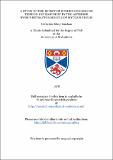Files in this item
A study of the effect of sudden cooling on tension development by the anterior byssus retractor muscle of mytilus edulis
Item metadata
| dc.contributor.author | Linehan, Catherine Mary | |
| dc.coverage.spatial | 123 p. | en_US |
| dc.date.accessioned | 2018-07-03T08:44:26Z | |
| dc.date.available | 2018-07-03T08:44:26Z | |
| dc.date.issued | 1978 | |
| dc.identifier.uri | https://hdl.handle.net/10023/14824 | |
| dc.description.abstract | The effect of ambient temperature on the ACh-induced tension response of the ABRM of Mytilus edulis was examined. The latter was found to have many temperature dependent variables, these included the latent period, the rate of tension development, maximum tension and the relaxation rate. Pmax was found to show a negative temperature coefficent. K+ contractures also showed a negative temperature co-efficent, Pmax approximately doubling for a 20°C decrease in temperature. The application of a cold shock during an ACh-induced contraction-relaxation cycle resulted in a transient increase in tension, the CIC. The production of a CTC was found to be dependent on the immediate presence of a stimulant, the time of application of the cold shock after the addition of stimulant, muscle length and temperature difference. As the temperature difference (ΔT) between the initial and cold shock solutions increased so the size of the CIC increased. The production of a CIC was found not to be directly related to the ACh or to the active state level yet it did not appear to be a passive phenomenon. A CIC was not produced when cold shock was applied to a muscle at rest or during catchy however, when catch was abolished by the application of relaxant a CIC could once again be elicited. Kinetic analysis of the CIC showed that, however, complex the mechanism two steps appear to be rate limiting, and the increase in tension with increasing AT was probably due to an increase in the availability of activator responsible for its production, rather than a differential effect on one of the rate limiting steps. Although it is conceivable that cold shock may exert a direct effect on the contractile proteins, evidence from the literature, and the experiments reported here, suggest that it is more likely that the CTC results from a transient increase in the level of myoplasmic Ca+2 Pharmacological investigation did not disprove this hypothesis. Of the possible sources of Ca+2 responsible for the CIC membrane associated sites seemed the most likely since under conditions which deplete this site no CIC was observed. Also the involvement of cAMP in the production of the CIC was largely excluded. | en_US |
| dc.language.iso | en | en_US |
| dc.publisher | University of St Andrews | |
| dc.subject.lcc | QP321.L5 | |
| dc.subject.lcsh | Muscles | en |
| dc.title | A study of the effect of sudden cooling on tension development by the anterior byssus retractor muscle of mytilus edulis | en_US |
| dc.type | Thesis | en_US |
| dc.contributor.sponsor | Action Medical Research | en_US |
| dc.type.qualificationlevel | Doctoral | en_US |
| dc.type.qualificationname | PhD Doctor of Philosophy | en_US |
| dc.publisher.institution | The University of St Andrews | en_US |
This item appears in the following Collection(s)
Items in the St Andrews Research Repository are protected by copyright, with all rights reserved, unless otherwise indicated.

